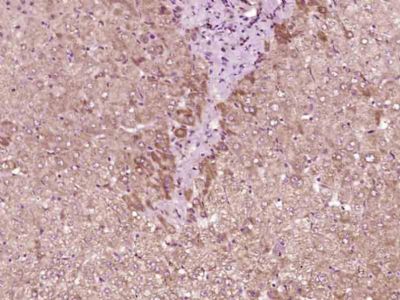IL-9 Polyclonal Antibody
Purified Rabbit Polyclonal Antibody (Pab)
- SPECIFICATION
- CITATIONS
- PROTOCOLS
- BACKGROUND

Application
| IHC-P, IHC-F, IF, ICC, E |
|---|---|
| Primary Accession | P15248 |
| Host | Rabbit |
| Clonality | Polyclonal |
| Calculated MW | 16 KDa |
| Physical State | Liquid |
| Immunogen | KLH conjugated synthetic peptide derived from human IL-9 |
| Epitope Specificity | 51-144/144 |
| Isotype | IgG |
| Purity | affinity purified by Protein A |
| Buffer | 0.01M TBS (pH7.4) with 1% BSA, 0.02% Proclin300 and 50% Glycerol. |
| SUBCELLULAR LOCATION | Secreted. |
| SIMILARITY | Belongs to the IL-7/IL-9 family. |
| Important Note | This product as supplied is intended for research use only, not for use in human, therapeutic or diagnostic applications. |
| Background Descriptions | The protein encoded by this gene is a cytokine that actsas a regulator of a variety of hematopoietic cells. This cytokinestimulates cell proliferation and prevents apoptosis. It functionsthrough the interleukin 9 receptor (IL9R), which activatesdifferent signal transducer and activator (STAT) proteins and thusconnects this cytokine to various biological processes. The geneencoding this cytokine has been identified as a candidate gene forasthma. Genetic studies on a mouse model of asthma demonstratedthat this cytokine is a determining factor in the pathogenesis ofbronchial hyperresponsiveness. [provided by RefSeq, Jul 2008]. |
| Gene ID | 3578 |
|---|---|
| Other Names | Interleukin-9, IL-9, Cytokine P40, T-cell growth factor P40, IL9 |
| Dilution | IHC-P=1:100-500,IHC-F=1:100-500,ICC=1:100-500,IF=1:100-500,ELISA=1:5000-10000 |
| Storage | Store at -20 ℃ for one year. Avoid repeated freeze/thaw cycles. When reconstituted in sterile pH 7.4 0.01M PBS or diluent of antibody the antibody is stable for at least two weeks at 2-4 ℃. |
| Name | IL9 |
|---|---|
| Function | Multifunctional cytokine secreted mainly by T-helper 2 lymphocytes and also mast cells or NKT cells that plays important roles in the immune response against parasites (PubMed:29742432). Affects intestinal epithelial permeability and adaptive immunity (PubMed:29742432). In addition, induces the differentiation of specific T-cell subsets such as IL-17 producing helper T-cells (TH17) and also proliferation and differentiation of mast cells. Mechanistically, exerts its biological effects through a receptor composed of IL9R subunit and a signal transducing subunit IL2RG. Receptor stimulation results in the rapid activation of JAK1 and JAK3 kinase activities leading to STAT1, STAT3 and STAT5-mediated transcriptional programs. Induction of differentiation genes seems to be mediated by STAT1 alone, while protection of cells from apoptosis depends on STAT3 and STAT5. |
| Cellular Location | Secreted. |

Thousands of laboratories across the world have published research that depended on the performance of antibodies from Abcepta to advance their research. Check out links to articles that cite our products in major peer-reviewed journals, organized by research category.
info@abcepta.com, and receive a free "I Love Antibodies" mug.
Provided below are standard protocols that you may find useful for product applications.
If you have used an Abcepta product and would like to share how it has performed, please click on the "Submit Review" button and provide the requested information. Our staff will examine and post your review and contact you if needed.
If you have any additional inquiries please email technical services at tech@abcepta.com.













 Foundational characteristics of cancer include proliferation, angiogenesis, migration, evasion of apoptosis, and cellular immortality. Find key markers for these cellular processes and antibodies to detect them.
Foundational characteristics of cancer include proliferation, angiogenesis, migration, evasion of apoptosis, and cellular immortality. Find key markers for these cellular processes and antibodies to detect them. The SUMOplot™ Analysis Program predicts and scores sumoylation sites in your protein. SUMOylation is a post-translational modification involved in various cellular processes, such as nuclear-cytosolic transport, transcriptional regulation, apoptosis, protein stability, response to stress, and progression through the cell cycle.
The SUMOplot™ Analysis Program predicts and scores sumoylation sites in your protein. SUMOylation is a post-translational modification involved in various cellular processes, such as nuclear-cytosolic transport, transcriptional regulation, apoptosis, protein stability, response to stress, and progression through the cell cycle. The Autophagy Receptor Motif Plotter predicts and scores autophagy receptor binding sites in your protein. Identifying proteins connected to this pathway is critical to understanding the role of autophagy in physiological as well as pathological processes such as development, differentiation, neurodegenerative diseases, stress, infection, and cancer.
The Autophagy Receptor Motif Plotter predicts and scores autophagy receptor binding sites in your protein. Identifying proteins connected to this pathway is critical to understanding the role of autophagy in physiological as well as pathological processes such as development, differentiation, neurodegenerative diseases, stress, infection, and cancer.


